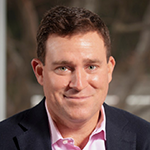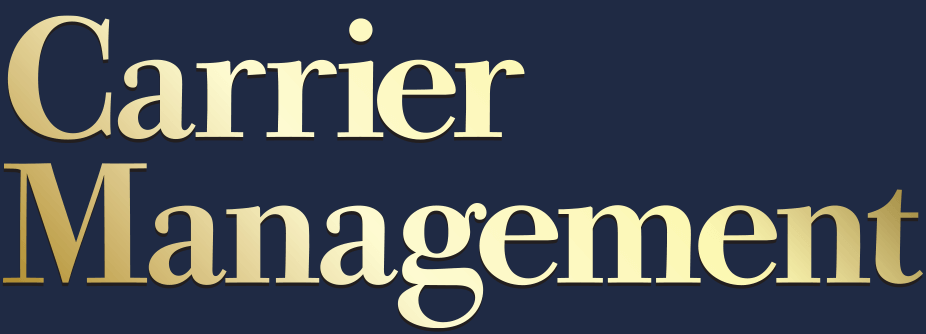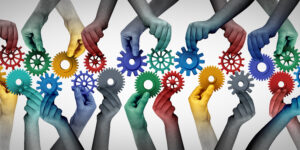As insurance leaders gain a better handle on the challenges of embracing technology, another challenge is emerging: making sure technology doesn’t replace humanity in team building.
“The biggest issue right now facing an organization of our scale — an organization of your scale — is that scale has the risk of eating humanity, and scale and humanity fight each other in cultures,” said Dan Helfrich, principal and former Chair and CEO of Deloitte Consulting LLP.
Helfrich was speaking at the Travelers Institute’s Forces at Work Symposium at the New York Stock Exchange in April. He said one of the biggest responsibilities for insurance leaders building tech-forward teams is to keep humanity alive in order to nurture talent and stay competitive.
“I think it’s incumbent upon all of us who get entrusted with the privilege of leading an organization of our scale and stature to make sure that humanity stays alive in the decisions we make and the way we communicate and the way we try to engage,” he said. “Because if you don’t manage this scale — which the markets love and growth is a great thing — but if it saps us of humanity, then you become very ordinary as an organization.”
Mojgan Lefebvre, executive vice president and chief technology and operations officer at Travelers, said part of this process is creating a culture in which continuous learning and growth are top of mind for all employees.
“I joined Travelers in 2018, and as we set our technology strategy, it was very tightly coupled with our business objectives. Of course, we were very focused on modernizing our technology foundation, focusing on the customer and employee experience,” she said. “But I’m such a big believer that at the end of the day, it all comes down to the people, and so the first strategic priority we set in place was investing in our people.”
The team at Travelers seeks to provide dedicated time for each of its tech employees to upskill, she said.
“Our goal was to make sure that we got to a point where every single person was doing the right work with all the skills that they needed or the tools they needed,” she said. “It was also very clear to us that we needed to shift from the traditional reactive IT mindset and approach to much more of an engineering design-oriented approach, much more automation, really proactive.”
Harnessing a Growth Mindset
Helfrich added that in a competitive talent landscape, this growth mindset is a differentiating factor for large companies as new talent is being drawn in by the ability to learn rather than the brand itself.

“What our data would say is for tech talent, brand isn’t actually the sexy differentiator. It is learning pathways and it’s agency to work on really interesting things,” he said. “People — particularly in the early stages of their career — they want to see an organization that is investing in tangible learning because people appropriately view that as the currency that’s going to help them as their career moves forward.”
Lefebvre said that it became critical at Travelers to focus on engineering excellence and create a culture that draws a pipeline of talent. The company worked on positioning itself this way, changing how it went to market, and showing up where the talent is.
“We are competing in fact with the Amazons and Googles and others of the world for that top talent. So it’s about, first of all, making sure we’re positioning as a technology company as well,” she said. “Then, the work that we do is really exciting. I mean, we are a data company at the core of it. We’re making decisions around risk.”
Developing Tech Fluidity
Part of this focus on upskilling means developing what Lefebvre refers to as full stack or t-shaped skillsets. This means employees need to not only have deep expertise in one or two areas, but also the ability to navigate across the software development life cycle or value chain so that they can change roles easily and not become siloed.
“Management teams who have no one that’s tech fluid at the table are really going to struggle because at the end of the day, so many of the decisions you are confronting are technology influenced decisions,” Helfrich added. “If you don’t have people around the table keeping pace with technology at the pace that it’s evolving right now, then you are putting yourself at a big deficit relative to competitors.”

Once the right tech talent is in place and the skills are developed, the question becomes how to retain the human element, both panelists said. This involves striking a balance between autonomy and structure.
“You want to build the most empowered teams that really own the decision making, but certainly, you’ve got to do it in a way that’s aligned to the outcomes you want to achieve,” Lefebvre said. “We call it autonomy with alignment.”
Helfrich agreed that he likes to call this approach ‘freedom within a framework’ and he sees this as the cultural magic that allows companies to build a successful multi-generational workforce.
“What you are seeking to do is combine empowerment and standardization, which is a really nuanced needle to thread,” he said. “But when she says autonomy with alignment, when I say freedom within the framework, the organizations and teams that navigate that mixture of empowerment with standardization and clarity and norms are going to be the winners. Right now, we have some organizations that are probably overly fixated on the freedom or autonomy dimension and others that are confident that if they have the framework defined and get everyone aligned, that’s the answer. I think the magic’s in between.”





















 Women Are Now Leaning Out in the Workplace
Women Are Now Leaning Out in the Workplace  How One MGU Grew Fivefold When Capacity Fled Cat-Prone Property Markets
How One MGU Grew Fivefold When Capacity Fled Cat-Prone Property Markets  Aon Adds to List of Brokers Suing Howden US for Alleged Poaching, Theft
Aon Adds to List of Brokers Suing Howden US for Alleged Poaching, Theft  Acrisure to Buy MGA Vave From Canopius
Acrisure to Buy MGA Vave From Canopius 
